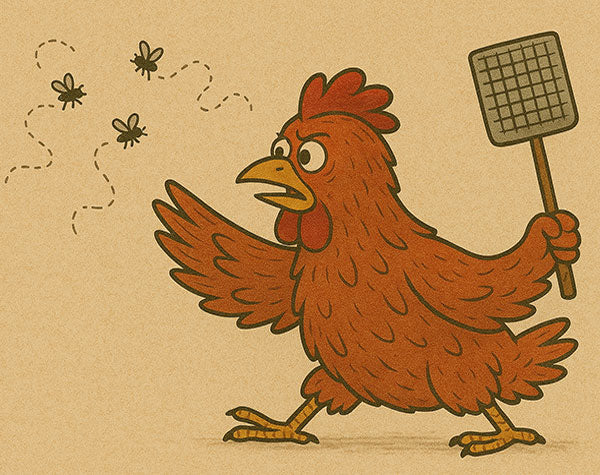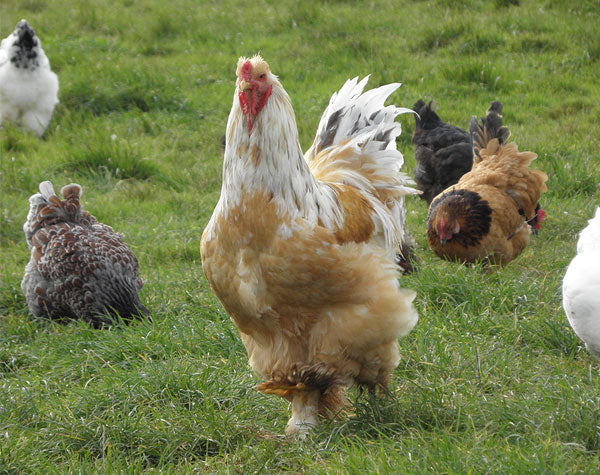🐓 Chicken Health Compendium
This page covers: Physical & Environmental Issues.
Part of our Chicken Health Hub - a guide to identifying, preventing, and treating common poultry health issues.
Not all chicken health problems come from germs - sometimes, their surroundings and daily habits are the real culprits.
From cramped housing to icy winters, from a badly aimed peck to a curious nibble of something toxic, the environment can be just as risky as any infection. The good news? Many of these problems are easily prevented with the right housing, diet, and a watchful eye.
In this section, we cover the common physical and environmental challenges your flock might face - and how to spot, prevent, and treat them before they ruffle too many feathers.
In this section: Impacted Crop · Bumblefoot · Prolapse · Fly Strike · Egg Bound · Deformed Eggs · Feather Loss · Egg Eating · Frostbite · Favus · Poisoning · Wry Neck
Impacted Crop
An impacted crop is a blockage in the crop, often from long grass, straw/hay, or foreign material, which can make the crop feel bulbous (like plasticine), especially noticeable in the morning.
Symptoms
- Crop full and hard in the morning
- Loss of appetite
- Lethargy
- Weight loss
Prevention
- Avoid long fibrous grass and indigestible materials
- Provide grit to help break up fibres e.g. Poultry Hen Grit
- Apple Cider Vinegar (ACV) in drinking water to aid digestion
Treatment
- A few drops of olive oil into the beak; gently massage crop
- Withhold food; offer water with ACV
- Vet may flush or surgically empty in severe cases
Bumblefoot
A bacterial infection (often Staphylococcus aureus) in the foot, typically following a small wound, poor perches, or hard/sharp landing surfaces. Watch our short video: What is Bumblefoot?
Symptoms
- Swollen foot pad with a black scab or distinct lump
- Limping or reluctance to stand
- Heat or redness in the foot
Prevention
- Soft bedding in the henhouse (HempBed)
- Avoid hard landing surfaces in their run (use Wood Chip)
- Keep perches sensible height (≈ 18–24″, breed-dependent)
- Remove sharp objects; keep floor clean and dry
Treatment
- Soak foot in warm Epsom-salts
- Remove scab; clean wound (advanced cases need a vet)
- Apply Wound Antiseptic and bandage; repeat as needed
Prolapse (Vent Prolapse)
Part of the oviduct protrudes through the vent, often after laying a large or misshapen egg. Needs quick attention to prevent pecking and infection; will most likely recur.
Symptoms
- Bright red tissue visible at the vent
- Straining or hunched posture
- Blood/pecking from other birds
- Sudden stop in laying
Prevention
- Maintain a healthy weight; avoid obesity
- Balanced calcium and protein
- Adequate daylight
- Don’t encourage early (young) laying
Treatment
- Isolate to prevent pecking
- Gently clean and lubricate the prolapse
- Reinsert with gloved, lubricated fingers
- Apply anti-peck spray; consult a vet
Fly Strike
Flies lay eggs on soiled feathers or wounds; maggots hatch and eat into tissue. A rapid, serious condition needing urgent action. Read our blog: Fly Strike - It's Horrible!
Symptoms
- Foul smell
- Maggots near the vent or in wounds
- Lethargy; reluctance to move
- Sudden collapse/shock
Prevention
- Keep the vent area clean and dry
- Treat diarrhoea/wounds promptly
- Daily checks in warm weather
- Reduce flies e.g. Flytraps nearby (not over the run)
Treatment
- Isolate; carefully clip and clean the affected area
- Remove all maggots; bathe in warm water; apply an antiseptic
- Seek immediate veterinary care
Egg Bound
A hen cannot pass an egg, causing internal blockage and pain. Can lead to prolapse if not resolved. Do not break the egg inside the hen. Here is our short video onHow can I tell if a Hen is Egg Bound.
Symptoms
- Hunched posture; straining
- No egg laid despite nesting behaviour
- Pale comb, lethargy
- Swollen abdomen/vent area
Prevention
- Calcium-rich diet; access to grit
- Maintain a healthy weight
- Avoid inducing very early laying with artificial light
Treatment
- Warm bath; gentle abdominal massage
- Lubricating jelly around vent
- Isolate somewhere warm and quiet
- Vet help if unresolved within 24 hours
Deformed Eggs
Odd shapes, thin/brittle shells, wrinkles, or shell-less eggs are usually due to stress or shock, commonly their age, or a recent illness. It can also happen when they are coming into first lay, or coming out of the moult. For more details, hints and tips, read our blog: Common Egg Shell Problems.
Symptoms
- Misshapen or shell-less eggs
- Thin, brittle, or wrinkled shells
- Bumps, ridges, unusual textures
Prevention
- Consistent, high-quality layer feed with calcium
- Minimise stress/overcrowding
- Fresh water; oyster shell/grit available
Treatment
- Often resolves itself
- Treat underlying issues (stress, illness, parasites)
- Give a calcium tonic for older birds
- Consult a vet for persistent reproductive problems
Feather Loss
May be due to moult, parasites, bullying, over-mating, or poor diet. In some cases, it can be Depluming Mite (see Parasites page). These links take you to our more detailed blog Feather Loss - the Answers and to our videos How to Stop Feather Pecking and Feather Loss in Chickens.
Symptoms
- Bald patches on neck, back, breast, or around the vent
- Red or irritated skin
- Loose feathers in run/coop
- Reduced laying/energy during moult
Prevention
- Balanced diet with good protein
- Avoid overcrowding
- Balanced rooster-to-hen ratio
Treatment
- Identify cause (parasites, pecking, etc.)
- Boost protein during regrowth
- Anti-peck sprays; poultry saddles if needed
- Temporarily isolate the aggressor or the victim if necessary
Egg Eating
Hens peck and eat their own or others’ eggs, often from boredom, nutrient deficiency, or accidental discovery. Hard habit to break. Watch our short video for tips on How to Prevent Hens Eating Their Eggs.
Symptoms
- Eggshell fragments or yolk in nest boxes
- Fewer eggs collected despite laying behaviour
- Hens seen pecking eggs
Prevention
- Collect eggs frequently
- Roll-away nest boxes if it starts
- Enrichment to reduce boredom
- Adequate calcium and protein
Treatment
- Identify and separate culprits
- Use ceramic/rubber dummy eggs
- Darken nest boxes
- Watch our video above
Frostbite
Extreme cold leading to injury to combs, wattles, or toes. Correct house size helps birds share warmth at night; avoid adding heat (moving from a warm house to cold air can worsen issues).
Symptoms
- Blackened comb/wattles
- Swelling or blistering of soft tissue
- Pain; reluctance to walk
- Severe cases may lead to tissue loss
Prevention
- Dry, draught-free coop with good ventilation
- Avoid damp bedding; add extra in winter e.g HempBed
- Match house size to flock size for shared warmth
- Petroleum jelly on large combs in extreme cold
Treatment
- Do NOT rub or rewarm too quickly
- Keep birds warm together at night (no heaters)
- Apply antiseptic spray if skin cracks
- Vet care if severe
Favus (Ringworm)
Fungal skin infection affecting comb, wattles, sometimes the face; may cause feather loss around the head. Rare in UK commercial flocks but can occur in backyard birds. Not life-threatening if caught early and can clear up naturally.
Symptoms
- White, powdery or crusty patches on comb/wattles
- Dry, flaky skin
- Can spread to other birds (and occasionally humans)
Prevention
- Keep coop dry and well-ventilated
- Isolate affected birds
- Good hygiene; disinfect equipment
Treatment
- Over-the-counter antifungal creams/iodine
- Petroleum Jelly (Vaseline) can soothe and reduce spread
- Disinfect coop/equipment (e.g. Virkon S)
- Continue treatment 1–2 weeks beyond symptom resolution
Poisoning
Ingestion of toxins such as mouldy feed, poisonous plants, pesticides, or rodenticides. See also: What to Avoid Feeding Your Chickens.
Symptoms
- Vomiting, diarrhoea
- Tremors, paralysis
- Sudden collapse or seizures
- Green or discoloured droppings
Prevention
- Store feed correctly; keep dry and rodent-proof
- Keep toxic plants/chemicals out of reach
- Use poultry-safe pest control methods
Treatment
- Identify and remove access to the toxin
- Provide fresh water; activated charcoal only if advised by a vet
- Seek urgent veterinary attention for severe signs
Wry Neck (Torticollis / Twisted Neck)
Neurological condition where the neck twists/tilts. Most often due to Vitamin E/Selenium deficiency in young birds, but also head injury, genetics, or secondary to infections (e.g. Marek’s, Newcastle). See our short video here: What is Wry Neck?
Symptoms
- Head twisted or tilted (upside down, sideways, or back)
- Loss of balance/coordination
- Difficulty eating or drinking
- May be constant or worsen over time
Prevention
- Balanced diet with adequate vitamin E and selenium
- Reduce coop hazards that could cause head injury
- Use healthy breeding stock
Treatment
- Supplement vitamin E and selenium (or a tonic high in both)
- Supportive care: hand-feeding/hydration if needed
- Isolate to prevent bullying; recovery may take 1–14 days
- - - - - -



